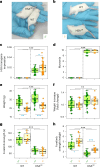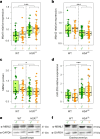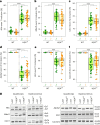Use of HSALR female mice as a model for the study of myotonic dystrophy type I
- PMID: 40016516
- PMCID: PMC11957995
- DOI: 10.1038/s41684-025-01506-7
Use of HSALR female mice as a model for the study of myotonic dystrophy type I
Abstract
HSALR mice are the most broadly used animal model for studying myotonic dystrophy type I (DM1). However, so far, HSALR preclinical studies have often excluded female mice or failed to document the biological sex of the animals. This leaves an unwanted knowledge gap concerning the differential development of DM1 in males and females, particularly considering that the disease has a different clinical presentation in men and women. Here we compared typical functional measurements, histological features, molecular phenotypes and biochemical plasma profiles in the muscles of male and female HSALR mice in search of any significant between-sex differences that could justify this exclusion of female mice in HSALR studies and, critically, in candidate therapy assays performed with this model. We found no fundamental differences between HSALR males and females during disease development. Both sexes presented comparable functional and tissue phenotypes, with similar molecular muscle profiles. The only sex differences and significant interactions observed were in plasma biochemical parameters, which are also intrinsically variable in patients with DM1. In addition, we tested the influence of age on these measurements. We therefore suggest including female HSALR mice in regular DM1 studies, and recommend documenting the sex of animals, especially in studies focusing on metabolic alterations. This will allow researchers to detect and report any potential differences between male and female HSALR mice, especially regarding the efficacy of experimental treatments that could be relevant to patients with DM1.
© 2025. The Author(s).
Conflict of interest statement
Competing interests: The authors declare no competing interests.
Figures





Similar articles
-
Calcitriol increases MBNL1 expression and alleviates myotonic dystrophy phenotypes in HSALR mouse models.J Transl Med. 2022 Dec 12;20(1):588. doi: 10.1186/s12967-022-03806-9. J Transl Med. 2022. PMID: 36510245 Free PMC article.
-
Furamidine Rescues Myotonic Dystrophy Type I Associated Mis-Splicing through Multiple Mechanisms.ACS Chem Biol. 2018 Sep 21;13(9):2708-2718. doi: 10.1021/acschembio.8b00646. Epub 2018 Aug 27. ACS Chem Biol. 2018. PMID: 30118588 Free PMC article.
-
Therapeutic impact of systemic AAV-mediated RNA interference in a mouse model of myotonic dystrophy.Hum Mol Genet. 2015 Sep 1;24(17):4971-83. doi: 10.1093/hmg/ddv219. Epub 2015 Jun 16. Hum Mol Genet. 2015. PMID: 26082468 Free PMC article.
-
Dissecting Pathogenetic Mechanisms and Therapeutic Strategies in Drosophila Models of Myotonic Dystrophy Type 1.Int J Mol Sci. 2018 Dec 18;19(12):4104. doi: 10.3390/ijms19124104. Int J Mol Sci. 2018. PMID: 30567354 Free PMC article. Review.
-
Myotonic dystrophy type 2.Eur J Neurol. 2002 Sep;9(5):441-7. doi: 10.1046/j.1468-1331.2002.00453.x. Eur J Neurol. 2002. PMID: 12220374 Review.
References
-
- Liao, Q., Zhang, Y., He, J. & Huang, K. Global prevalence of myotonic dystrophy: an updated systematic review and meta-analysis. Neuroepidemiology56, 163–173 (2022). - PubMed
-
- Brook, J. D. et al. Molecular basis of myotonic dystrophy: expansion of a trinucleotide (CTG) repeat at the 3′ end of a transcript encoding a protein kinase family member. Cell68, 799–808 (1992). - PubMed
-
- Mahadevan, M. et al. Myotonic dystrophy mutation: an unstable CTG repeat in the 3′ untranslated region of the gene. Science255, 1253–1255 (1992). - PubMed
MeSH terms
Grants and funding
- FDEGENT/2020/001/Generalitat Valenciana (Regional Government of Valencia)
- PROMETEO/2020/081/Generalitat Valenciana (Regional Government of Valencia)
- OP ERDF of Comunitat Valenciana 2014-2020/EC | European Regional Development Fund (Europski Fond za Regionalni Razvoj)
- HR17-00268/'la Caixa' Foundation (Caixa Foundation)
- DTS19/00128/Ministry of Economy and Competitiveness | Instituto de Salud Carlos III (Institute of Health Carlos III)
LinkOut - more resources
Full Text Sources
Miscellaneous

